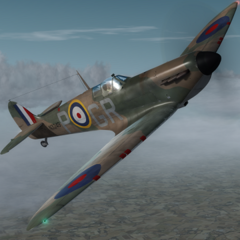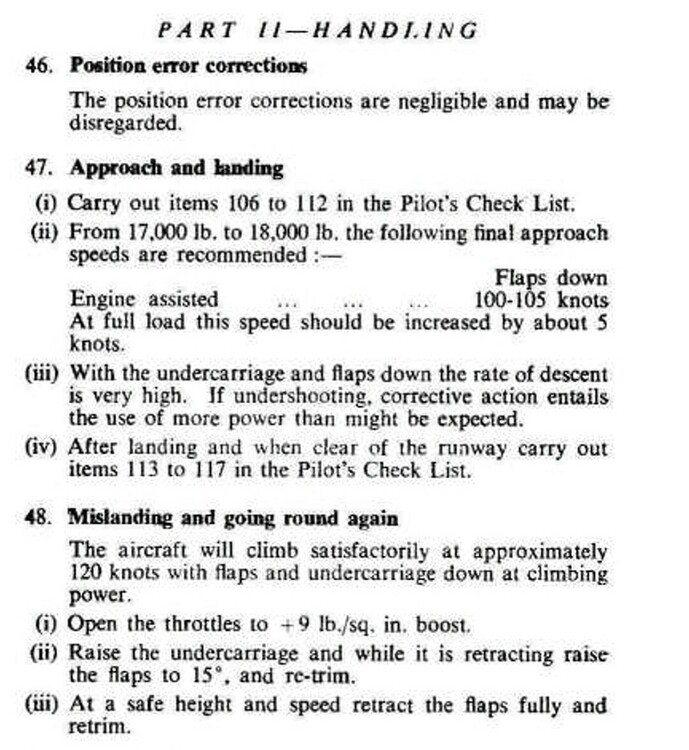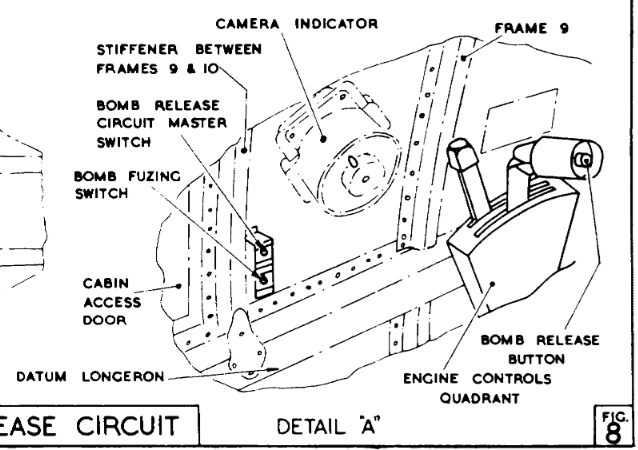-
Posts
282 -
Joined
-
Last visited
Content Type
Profiles
Forums
Events
Everything posted by Skewgear
-

perfect time to bring bf-109 G6 in to DCS
Skewgear replied to noelgallagher's topic in DCS: Normandy 2.0
Despite all the whinging and moaning we see about this, we never get similar from owners of the Spitfire (second slowest in the DCS WW2 plane set), P-47 (great up high, great ground pounder, pretty poor elsewhere) or Mosquito (slowest of the DCS WW2 plane set, hopeless against single seaters). Me109 players who have convinced themselves that they can't fly multiplayer combat sorties without their beloved MW50 are not worth listening to. Man up or shut up - and learn to fight. -

Mosquito wing comes off at as low as 4.9G
Skewgear replied to J13 Serenity's topic in Bugs and Problems
See the attached flying limitations for the Mosquito FB.VI, taken from the Royal Australian Air Force's Mosquito Instruction No.1 dated 8th December 1944. Page 24 of the first PDF at the following link: Remember that post-war editions of RAF pilots' notes (meaning the digitised original copy that everyone always refers to in online Mosquito FB.VI discussions, with speeds in knots) do not include a significant amount of information that was in the wartime documents. This is because after the war, the requirement to carry bombs and rockets on these aircraft largely fell away as they were relegated to second line duties and training roles. My personal view is the post-war FB.VI pilots' notes omit important information for the pilot including many of these limitation speeds. I fly in accordance with them and I don't find myself tearing off my wings. Adding link because the forum software swallowed it: https://ww2aircraft.net/forum/threads/raaf-mosquito-reports.55455/ -

Mosquito wing comes off at as low as 4.9G
Skewgear replied to J13 Serenity's topic in Bugs and Problems
Max permissible diving speed for the FB.VI with external bombs or rockets was 350mph. You're probably doing two things wrong: exceeding the speed and pulling out too sharply. -
It's bugged, we all know it's bugged, we proved it's bugged and doesn't behave like the real thing, and the result is that it's a won't-fix bug. A crying shame because before this gear bug spoilt it, the Mosquito was one of the best warbirds ED has made to date.
-

Why Don't WWII Fighters Explode In the Air?
Skewgear replied to Bowie's topic in Western Europe 1944-1945
The effect already exists on the Mosquito. Set one of those on fire and within a few minutes it starts falling apart. On the rest of the warbirds ... sigh. It's been reported for inclusion plenty of times. -
Max landing weight in the Mosquito FB.VI is 20,500lbs. Max takeoff weight is 22,300lbs. If you land overweight, you're going to damage the aircraft...
-
9lbs boost is the climb power setting. You want something between that and 12lbs for a normal takeoff. Be prepared to smoothly select 18lbs if the end is approaching faster than you'd like. Remember that not every runway on every map is long enough for a loaded Mosquito.
-
AP 2019E-PN, the Pilots' Notes for the FB.VI. Note very carefully that these were issued in the 1950s and the speeds given are in knots, not mph. This means you need to convert the given speeds to statute miles per hour, which is what our wartime Mosquito's ASI is calibrated in. 105kts = 121mph. 120kts = 138mph. No wonder many people are finding landing so hard - you're well on the back of the drag curve.
-
I was trying to be diplomatic
-
I'm limited in what I can say publicly, but the ED beta testers who are members of the Project Overlord team can and do raise problems and highlight bug fix candidates with ED. It's an uphill journey because the vast majority of DCS is focused on modelling jet systems in great depth. Bear in mind that that makes up about 90% of the game, so naturally gets a proportionate amount of attention compared with WW2. If you have 9 jet modules or missiles demanding major bug fixes and 1 WW2 module that needs a relatively low priority tweak (e.g. P-47 repair smashing the gear - yes it drives us all mad but at least there is a workaround of defuelling and dearming before repair), it's not hard to work out which problems need to be fixed first. Be in no doubt, DCS WW2 is a sideshow and that will not change. But we haven't been totally abandoned, despite the outward appearance of silence. FTAOD, PO isn't going anywhere either. Dev time on that has slowed because there is only a handful of us and we all have real life jobs and families.
-
Yes, though the Mosquito performance is marginal on the US airfields on the Cotentin peninsula especially if loaded with rockets. St Croix is a good runway length with plenty of margin for error.
-

Difference in fuel density between main and slipper fuel tanks
Skewgear replied to Lau's topic in DCS: Spitfire L.F. Mk. IX
247kg is 544lbs. This equates to a fuel weight of 6.4lbs/gal. Which is neither the RAF WW2 100/130 octane petrol weight nor the modern avgas weight. I will raise this. -

Difference in fuel density between main and slipper fuel tanks
Skewgear replied to Lau's topic in DCS: Spitfire L.F. Mk. IX
Standard weight of avgas is 6lbs per US gallon. For imperial gallons that figure is 7.2lbs per gallon. https://aviation.govt.nz/assets/publications/products/fuel-conversion-factors-sticker-avgas.pdf I don't have access to my rig at rhe moment but if someone could please check what DCS shows the full internal fuel weight as and post a screenshot, that would be helpful. I don't know where Lau's weights come from. AP1565J Vol 1, the Spitfire IX descriptive handbook, gives the correct empty and full weights plus moments to add or subtract from the CG. It also gives the 45 gallon torpedo tank as a 50 gallon item, interestingly. See below, and for blister tank read slipper tank. You can see by some elementary sums that the RAF weight for petrol is 6.2lbs/gallon. -

Dashboard lamp brightness controls are reversed
Skewgear replied to Lixma 06's topic in Bugs and Problems
Could you add a track file? Helps the devs pinpoint exactly what inputs relate to what actions and should illustrate the gain problem nicely. Doesn't need to be a long track at all - pick a cold start mission and spend 20 seconds turning the lights on and off. -
It's been deeply frustrating reading this thread two weeks after the block-headed wilful idiocy being displayed towards someone asking a reasonable question. No wonder users shy away from posting on these forums. Nealius. Ignore the oddball who was constantly telling you you're wrong and your understanding was invalid. He is not worth engaging with in good faith because he has been giving you bad faith answers throughout this thread. In English the terms prop pitch, prop RPM selector and prop lever are mostly interchangeable even when this is technically incorrect. The terms are widely understood to refer to levers that, when pushed forward, make the propeller spin faster. In that context "increasing" refers to higher RPM. This post is a great and simple explanation, including the relationship between propeller pitch setting and RPM:
-
You've checked your propeller pitch levers are fully forward, haven't you.
- 9 replies
-
- take off
- latest update
-
(and 1 more)
Tagged with:
-

ESSAY, PART 3: Landing and stopping.
Skewgear replied to Chief Instructor's topic in DCS: Spitfire L.F. Mk. IX
If that video tells you to touch down with the brakes on, that video is full of nonsense. Ignore it. You achieve a good landing by crossing the runway threshold at the correct speed. That's it. Fly the airspeed and everything becomes far easier. No gimmicks with brakes, no silliness Per the Pilots' Notes, 3rd Edition September 1946, this is 95mph for a clipped wing Spitfire at full training load (7,150lbs: full fuel, no ammo or bombs) and 90mph for a full wing Spitfire at the same weight. The approach speed is "20-25mph" above the threshold speed. -
I can't download the track from where I am at the moment so these questions may be obvious. Single player or multiplayer? How had you been flying before the failure? Gentle takeoff and climb to cruise? Full power scramble and dogfight? What height were you at?
-
The main problem is that there are no third parties making ETO DCS content (stand fast Ugra) despite a years-long proven market. My suspicion is ED will leave ETO with no further development as they move focus onto the PTO, which essentially means development is finished unless a third party decides to enter the market.
-
The engine limitations in the manual were for the real thing, to promote longer times between overhaul for the engine. In DCS you can thrash it, it's only got to last an hour or two. That aside, your Spitfire will be much happier being flown at book settings. Max continuous is a good combat cruise setting. Transit cruise, you can pull the revs back to around 2,350rpm and leave the boost somewhere around 0-2lbs. It'll positively sip fuel at that sort of power setting. In combat I keep max power use to a minimum, sitting around 14lbs unless I need the speed or acceleration. Watch the rad temp, 115C is tlwhere you need to consider throttling back. However, you can hit up to 125C without destroying anything. Key to engine life is oil pressure. Anything above 100psi, throttle back.
-
I don't think the issue is the gun, it's the damage models of whatever you're firing the gun at. The Spitfire gets properly clobbered by the 30mm every time unless you're unlucky and only clip a wing. Even then, a hit on the left radiator area invariably vents all the oil through the oil cooler for a mission kill. The Mosquito catches fire as soon as you look at it. I've blown the odd P-51 tail off but mostly that seems able to absorb several hits. The P-47 is very difficult to inflict meaningful damage on.
-
It's fine as is. The cooling system keeps a constant low level of flow going even when the thermostatic valve is "closed", else no heat would be removed from the engine at all.
-
Our Spitfire lacks the bomb control panel it should be fitted with. Currently there are no bomb release controls of any kind other than the release button in the throttle handle. All bombs release simultaneously and there is no emergency jettison or fuzing. This is not modelled, meaning bomb fuzing and release is not modelled correctly in-game. The Mk.IX was fitted with a six-way bomb fuze selector. This is described in the Spitfire IX manual AP 1565J Volume 1, Section 1, Amendment List 14. (the AL14 insert is attached below) Extra information is available in the Spitfire VIII manual, AP 1565H Volume 1 Section 6 (electrical and radio wiring and servicing), which describes the same switchbox and gives details of the electrical arrangements powering it: The illustration of the switchbox from AP 1565H is attached below, as is the illustration of the equivalent fitting for the Mk.V Spitfire. The Mk.IX switchbox is fitted in the same location. The full extract from AP 1565J Vol 1 AL14 detailing the bomb switchbox is here: https://forum.dcs.world/applications/core/interface/file/attachment.php?id=81126
-

4YA Project Overlord WW2 One Life Event
Skewgear replied to Skewgear's topic in Tournaments & Events
We stopped posting on the forums - didn't really seem to generate any interest and it was just another channel to keep on top of. With more than 60 pilots in the last event a couple of weeks ago we have plenty enough to keep us busy! Our event promotion is all on our Discord now. Link to that is on www.projectoverlord.co.uk -

Engine RPM telemetry not showing at low throttle
Skewgear replied to FinalGlide's topic in Bugs and Problems
If realism is your thing, it's worth knowing that tickover (ground idle) in the Spit means selecting 1,200rpm. You wouldn't leave the engine at idle (throttle against the stop) because that promotes plug fouling.









